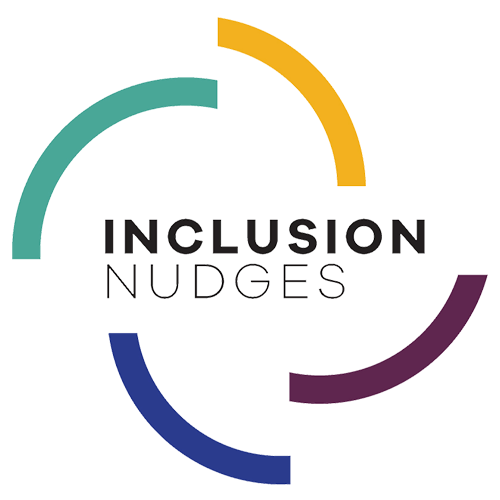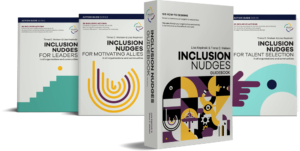In trying to convey ‘what is diversity’, many use images of colourful objects. Rarely are people actually shown, and if they are it tends to only be people of minority groups. This creates a problem for how we understand the concept of diversity–quite literally by the images that are shown. Instead, we need to frame perceptions to be inclusive of all people to be able to support the needed changes in behaviours and systems.
The cost of cute Images of ‘diversity’
We have seen first-hand how many well-intended organisations want to show their support of ‘diversity’ but struggle with their perception of the complexity of the concept. Getting clarity on the definition is a first step (as we advise in this blog article ), and doing this engages others in a shared understanding and mobilises them to be a part of the change efforts. As organisations communicate about their diversity, equity, and inclusion initiatives, the same deliberative attention is needed with selecting the images shown as with the words used. Yet all too often, we see photos of a colourful flowers, jelly beans, and drawing crayons used to depict ‘diversity’. The colours and images rarely show what we are talking about, which is PEOPLE, nor do the colours shown reflect the full range of human skin tones.
The problem with these types of images is that they can undermine the work done on setting clarity and reducing complexity in the definitions, strategy, and actions. These photos create emotional distance. Who sees themselves as a blue pencil? What politician or CEO identifies as a piece of red candy? These images mask what we are needing to focus on, which is ourselves and other people in our lives, workplaces, and communities. And while intentions are good with trying to somehow ‘celebrate diversity’ by showing these images, the risk is that a ‘happy face’ is put on what is the unpleasant reality of systemic discrimination, racism, sexism, xenophobia, harassment, and exclusion. It can be hard to ‘see’ hatred and its effects in a bouquet of colourful flowers!
And seeing is believing. ‘Cute’ and ‘pleasant’ images like these can indicate a superficial level of commitment to diversity initiatives. One that is more focused on making the people with power, status, and in the majority feel good about ‘diversity’. These metaphorical images don’t accurately reflect reality. They overlook the lived experiences of many people in the minority and out groups. They don’t align with the hard work needed to really ‘be diverse and inclusive’, such as taking responsibility, listening to others, examining power and privilege, spotting ingrained inequalities, doing de-biasing design work, having accountability, and more. An approach that uses ‘cute’ images can contribute to leaders and their organisations appearing disingenuous and merely doing ‘performative allyship’. Their credibility can be undermined, furthering the gap between intentions and actions for leveraging diversity, ensuring equity, and leading inclusively. Surely, no one wants this!
We have also seen in diversity reports, slide presentations, and other forms of communications how shades of gender stereotypical colours are over-used (pink for women, blue for men). This reinforces traditional and binary views of gender, activating stereotypes in our unconscious thinking. It can limit seeing the full range of humanity and gender expression. It also works to undermine any statements that ‘inclusion is of everyone’. The prevalent use of pink shades reduces diversity, equity, and inclusion initiatives to being a ‘women’s issue’ and it can become a hidden barrier to achieving the desired outcomes. Images and colours matter in shaping perceptions about diversity, and may actually work against intentions to be inclusive of all.
What is diversity?
For us in our work with leaders, change maker skills, communities, and organisations, here is how we define ‘diversity’.
“Diversity is about people. This includes their demographic differences, backgrounds, multiple identities, and their unique experiences, perspectives, knowledge, abilities, ideas, and more. Diversity is not referencing specific characteristics of only ‘the minority’ within a group of people or in society. Diversity is referencing all people and differences among us. Diversity is the mix of all of us.”
*The Inclusion Nudges Guidebook, by Lisa Kepinski & Tinna C. Nielsen
You can read more about how we define other terms such as inclusion, equity, and belonging in this Inclusion Nudges blog article called ‘Definitions Matter, Just Don’t Talk About Them’. In that article we also address, how the words we use can shape our diversity, equity, and inclusion initiatives. Here, we’re addressing how images equally play a role in this.
Leveraging the power of reality in images
In our conceptual framework, diversity is about all people. And as such, we encourage that images are used that show the real people within your context—employees, leaders, students, residents, teams, departments, organisations, communities, customers, etc. Using real people is important to accurately frame perceptions on what is being addressed with the diversity, equity, and inclusion efforts.
Be sure to show a range of all people, not just the people in minority groups. Members of the majority group must see themselves as equal partners in this work. For collective efforts and successful change, all people are needed. Be inclusive of all in your images used. Seeing all people shows reality on the current state of who are in our groups, which may be a surprise when we see this in real images. By seeing our previously hidden patterns, then our motivation for change-making actions can be increased. You can learn more about ways to reveal hidden patterns in this blog article .
Also, seeing real people’s faces (especially people that we know or are familiar to us), triggers our unconscious, system 1 thinking to be more engaged and primed to respond to information and requests. This works in two ways. One is that we have a heightened sense of being seen by others which increases our pro-social behaviours, and second is that we see others in action and we replicate their behaviours (the follow the herd effect). Also, images of real people show a more nuanced reality than a stereotype, which can have a significant impact on what we do, setting group norms, and changing the influence of stereotypes. Seeing human faces is far more powerful on action-taking than seeing a photo of an abstract, colourful object. And this is a power that we need to leverage in our diversity, equity, and inclusion initiatives.
We have many examples of designs where images can support intentions for diversity, equity, and inclusion. Some of these Inclusion Nudges are below. Each of these are written out step-by-step to make it easy for you to try them, and they also have behavioural insights and references to research on why they work.
- Images Framing Immigrants as One of Us in The Inclusion Nudges Guidebook and also in the inclusion Nudges for Motivating Allies
- Humanise Diversity Data & Trigger Supportive Behaviours in The Inclusion Nudges Guidebook and also in the inclusion Nudges for Motivating Allies
- Interrupt Gender Caregiver Stereotypes with Images in The Inclusion Nudges Guidebook and also in the inclusion Nudges for Motivating Allies
- Counter Stereotypes Using Images & Social Media in The Inclusion Nudges Guidebook and also in the inclusion Nudges for Talent Selection
Get access to more designs to achieve your diversity, equity, & inclusion initiatives
By applying Inclusion Nudges, you can more effectively achieve your diversity, equity, & inclusion initiatives. Inclusion Nudges make it easy to do this in a way that that engages all people and results in them being more motivated to take action. The research studies and the designs referenced in this article are described in step-by-step details in the Inclusion Nudges Guidebook, and also in the books in the Action Guide series. We encourage you to try applying the change methodology of Inclusion Nudges. These make inclusion the norm everywhere, for everyone, and by everyone.







